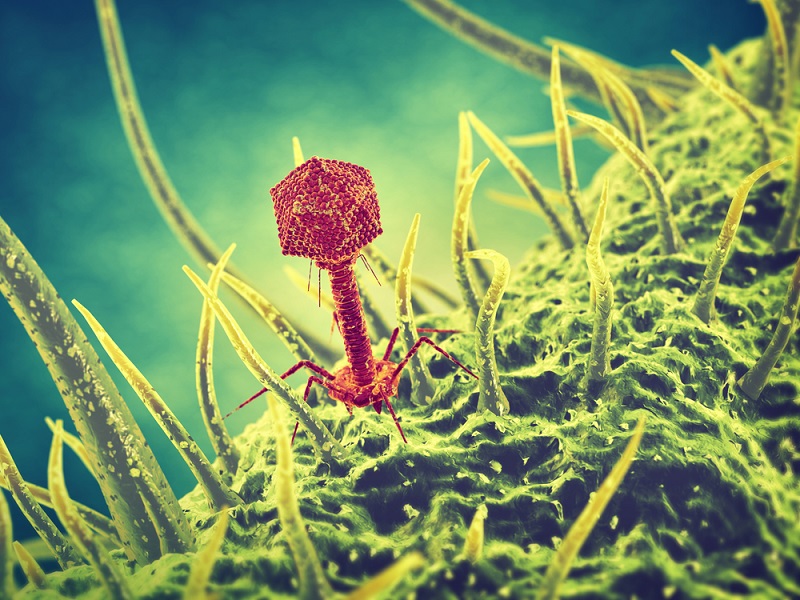A Man with a Life-Threatening Heart Infection Was Saved by a Virus Plucked from a Lake

A virus scooped up from a lake saved an 80-year-old Connecticut man who had a life-threatening bacterial infection in his heart.
Doctors had tried to combat the infection using antibiotics, to no avail. So they turned to a virus that was originally found in a nearby lake. The virus, a type called a bacteriophage, appeared to eradicate the patient's infection, according to a new report of the case.
Although larger studies are needed, the new report provides early evidence that bacteriophages could be effective treatments against some antibiotic-resistant infections, said the researchers from the Yale School of Medicine in New Haven, Connecticut.
The patient's troubles began in 2012 after he had heart surgery to replace a damaged section of his aorta — the artery that carries blood away from the heart. Doctors replaced this damaged section with a synthetic tube known as a graft.
But soon after the surgery, the man's graft got infected with a type of bacteria called Pseudomonas aeruginosa. This type of bacteria is common in the environment, and it is frequently linked to infections acquired in hospitals, according to the Centers for Disease Control and Prevention. [6 Superbugs to Watch Out For]
The patient was treated with a long-term course of antibiotics, but the infection kept coming back. He was admitted to the hospital numerous times over the next few years for P. aeruginosa infections in his blood, the report said.
As the patient was running out of treatment options, his physician was contacted by another researcher at Yale who had been studying bacteriophages and thought he had one that could help.
Sign up for the Live Science daily newsletter now
Get the world’s most fascinating discoveries delivered straight to your inbox.
This bacteriophage, known simply as OMKO1, was found in a sample taken from Dodge Pond, which is about 40 miles (64 kilometers) up the coast from New Haven. (The researchers had been studying natural samples for bacteriophages.)
Experiments in lab dishes had revealed that OMKO1 could kill P. aeruginosa bacteria by binding to the proteins on the bacterial surface that allow the bacteria to pump out antibiotic drugs before they cause harm. In doing so, the bacteriophages kill the bacteria. What's more, if the bacteria were to evolve to become resistant to OMKO1, they would have to change that pump, and without it, they become more susceptible to traditional antibiotics, the researchers said. That allows researchers to combat the bacteria with a "one-two punch" of sorts.
"The bacteria are backed into an evolutionary corner," study co-author Paul Turner, a professor of ecology and evolutionary biology at Yale University, said in a statement.
The researchers got approval from the Food and Drug Administration to use OMKO1 on the patient. In January 2016, they performed surgery to inject hundreds of thousands of OMKO1 bacteriophages into the man's chest.
Follow-up with the patient showed that he was free of his bacterial infection, despite taking antibiotics for only a short time after the surgery. So far, he has not had a recurrence of the infection and has remained off of antibiotics for 18 months, the report said.
"We argue that the phage therapy played a significant role in contributing to the eradication of the P. aeruginosa infection," the researchers wrote in the March 8 issue of the journal Evolution, Medicine and Public Health. "We hope that exploratory studies such as this one can provide preliminary evidence suggesting that phage OMKO1 can greatly improve the effects of antibiotics for the removal of P. aeruginosa," the study authors said.
The researchers are currently screening other types of bacteriophages to see if these might be effective treatments against other antibiotic-resistant bacteria, such as E. coli and Klebsiella pneumoniae, said study co-author Benjamin Chan, a research scientist at Yale.
Original article on Live Science.

Rachael is a Live Science contributor, and was a former channel editor and senior writer for Live Science between 2010 and 2022. She has a master's degree in journalism from New York University's Science, Health and Environmental Reporting Program. She also holds a B.S. in molecular biology and an M.S. in biology from the University of California, San Diego. Her work has appeared in Scienceline, The Washington Post and Scientific American.
Measles has long-term health consequences for kids. Vaccines can prevent all of them.
100% fatal brain disease strikes 3 people in Oregon










